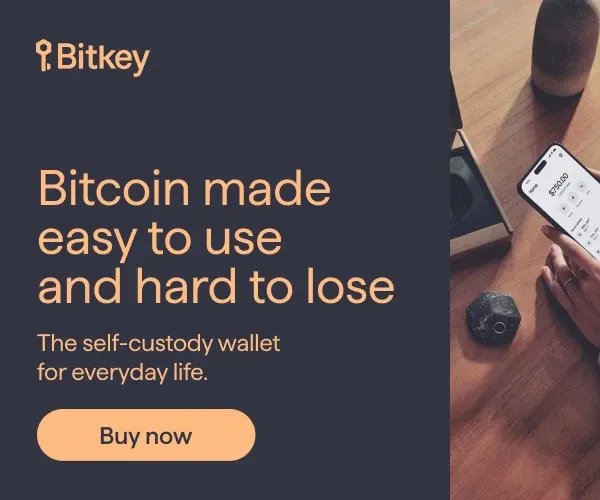Bitkey Review 2025: A Revolution In Bitcoin Self-Custody
There’s a quiet brilliance in how Bitkey handles bitcoin's complexity. It strips away noise without dumbing things down, turning BTC self-custody into something clear, secure, and genuinely easy to use. In this review we analyze how this wallet works and if it's the right choice for you.
Self-custodying your Bitcoin gives you complete control, no custodian fees, no restrictions on spending or moving your funds, and no reliance on third parties. The challenge, however, is the responsibility that comes with it. Managing private keys can be daunting, and mistakes are unforgiving. That’s where Bitkey comes in.
Bitkey is a self-custody Bitcoin wallet designed to make self-sovereignty simple. It features built-in multisig security by default, offering strong protection without the complexity usually associated with it.
Developed by the Proto team at Block (Jack Dorsey’s company), Bitkey is free and open-source (MIT License) from the ground up. Unlike most Bitcoin wallets, it has no screen and no buttons, taking an entirely different approach from what we’ve tested so far.
In this Bitkey review, we’ll take a close look at how it works, its security model, and whether it’s the right choice for your self-custody needs. Keep reading to find out more.
👉 Click here to get the Bitkey. Use code BITKEYBLOCKDYOR at checkout for an exclusive 10% discount.
| DESCRIPTION | DETAILS |
|---|---|
| 💻 Name | Bitkey |
| 🌐 Website | Bitkey.world |
| 🗓 Release year | 2023 |
| 💰 Coins Supported | Bitcoin (BTC) |
| 💸 Price | $150.00 / €150.00 (10% discount with BITKEYBLOCKDYOR coupon code) |
| 🔒 Security Features | 2-of-3 Multisig (Device + App + Block Server), Secure Enclave, Recovery Tools (Cloud + Social), App Biometric Lock, Anti-tamper Hardware Design |
| 📱 Compatibility | iOS and Android (via Bitkey app) |
| 🖥 Display | None (App) |
| 🔄 Connectivity | USB-C (charging only, no data) |
| 📏 Dimensions | Approx. 56mm x 62mm x 13mm (estimated) |
| ⚖️ Weight | Approx. 65 g (stone + steel construction) |
| 🔋 Battery Capacity | Rechargeable, 330mAh lithium-ion battery |
| 🛡️ Warranty | 1 Year (USA or outside Europe), 2 Years (Europe) |
| 📖 Open Source | Yes, MIT License: fully open-source (hardware, firmware, app, server) |
| 🔄 Firmware Reproducible | Yes, verifiable builds supported for firmware and app |
Bitkey Review: What Is It?

Bitkey is, first of all, not just a product but an ecosystem that it's composed of three things:
- Mobile app to make transactions easily on the phone
- A hardware device to protect savings securely offline
- A set of recovery tools in case customers lose their phone, hardware, or both
While analyzing Bitkey, I noticed a common theme between it and another famous product of the Block's family (Bitkey's Parent Company), the Square Reader: hardware isn’t the centerpiece, but rather an integrated part of a larger system where form follows function, enhancing both usability and security.

In 2010, the Square Reader revolutionized card payments by replacing clunky terminals with a small, seamless device that worked effortlessly with a smartphone app. It wasn’t just about the hardware: it was about rethinking the entire payment experience.
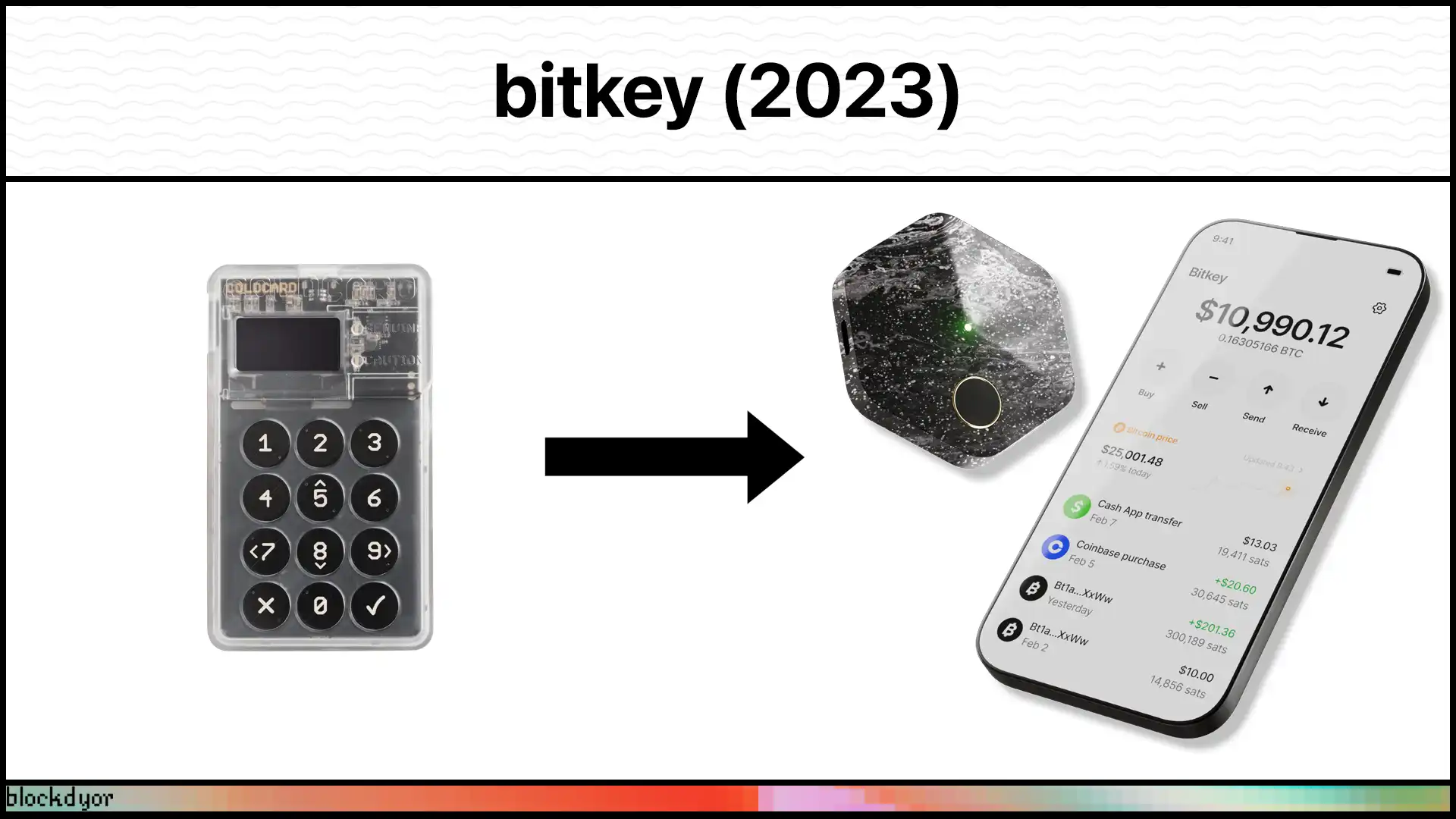
Bitkey does the same for Bitcoin self-custody. Before its arrival, managing seedphrases and multisig was complex, often requiring multiple devices: keypads, microSD cards, small screens, and several technical steps. While multisig is inherently more secure than single-signature wallets, its complexity made it inaccessible for many users. Even the simplest setup, a 2-of-3 multisig, was difficult to implement correctly.
Bitkey solves this elegantly. Like the Square Reader, its hardware blends into the broader system rather than being the focal point. The mobile app becomes the main interface, while the hardware wallet connects only via NFC, eliminating friction and attack surfaces. By making 2-of-3 multisig the default, Bitkey brings institutional-grade security to everyday users, without the usual complexity.
Brief Bitkey History
Before diving into Bitkey’s deep details, it’s important to understand its origins and how it differs from traditional hardware wallet companies.
Block, Inc.
Before Bitkey entered the market, Bitcoin wallets were mostly developed by smaller, specialized hardware wallet companies. Bitkey’s arrival marked a significant shift.

Bitkey is part of Block, Inc., a publicly traded company on the NYSE ($XYZ) with a market cap exceeding $80 billion. Led by CEO Jack Dorsey, a well-known Silicon Valley mogul (and also a Bitcoin advocate).
Block puts its money where its mouth is, allocating 10% of its monthly Bitcoin-related gross profit to Bitcoin investments, a move uncommon among large corporations.

Block’s ecosystem integrates Bitcoin across multiple services:
- Square – A payments platform for businesses, offering POS solutions.
- Cash App – A digital wallet with Bitcoin buying, selling, and withdrawal capabilities.
- Bitkey – A self-custody hardware wallet emphasizing security and ease of use.
- Proto – A suite of Bitcoin mining products, including the first U.S.-made open-source ASIC chip.
- Tidal – A music streaming service.
- AfterPay – A buy now, pay later financing option.
The Genesis
Square is considering making a hardware wallet for #bitcoin. If we do it, we would build it entirely in the open, from software to hardware design, and in collaboration with the community. We want to kick off this thinking the right way: by sharing some of our guiding principles.
— jack (@jack) June 4, 2021
Bitkey was developed by Block’s hardware division, Proto, the team behind Square’s POS system and Proto’s Bitcoin mining ASIC chip.

From the start, Bitkey took a different approach. Jack Dorsey and Jesse Dorogusker (formerly of Apple, Square, and Tidal) assembled a small, cross-functional team led by Max Guise to build the wallet from the ground up. They combined expertise in hardware, design, manufacturing, and supply chain to create a Bitcoin custody solution that stands apart.
The team developed Bitkey “in the open,” sharing progress on their blog, bitkey.build, and incorporating user feedback through S.P.A.D.E., a structured decision-making framework popularized at Google, Facebook, and widely used within Block.
Every major component and feature was carefully evaluated, leading to unconventional choices, such as removing a built-in display, keypad and even seedphrases. Instead of making the hardware the centerpiece, they designed the mobile app as the primary interface, creating a more accessible, secure, and cost-effective self-custody solution.
The Arrival
make your #bitcoin very hard to lose and easy to use.
— jack (@jack) March 13, 2024
starts shipping today.https://t.co/x1oLkjhs0H
Since the first Jack message on Twitter/X around 3 years (and a though bear market) passed, where the team worked insatiably in the open by posting blog posts about their decision for this new wallet.
Finally the Bitkey arrived in pre-order on the Bitkey website in late 2023 and started shipping on the 14 march 2024.
Bitkey Main Features
Since Bitkey combines both an app and a hardware device, new features keep rolling out over time with OTA updates. Here are the 10 most important ones so far.
- Seedless Security: You don’t need to write down or store a seed phrase. That removes a huge single point of failure and simplifies self-custody.
- Three-Key Multisig: Bitkey uses a 2-of-3 key setup: one on your phone, one on the Bitkey hardware device, and one on Block’s servers.The hardware device is required for every transaction, unless you enable the “Transfer without hardware” feature with daily limits.
- Cloud Backup & Recovery: Lost or changed your phone? You can restore using encrypted cloud backups and your Bitkey device or a trusted contact. No seed required.
- Inheritance: Name a beneficiary who can inherit your Bitcoin securely after you pass away. A 6-month delay period protects against false claims and gives you time to cancel if needed.
- Delay + Notify Safeguards: If someone tries to recover your wallet without your permission, Bitkey alerts you and delays the process. You can stop it anytime during that window.
- Social Recovery: Add a trusted contact to help you recover funds if you lose your phone and can’t access your cloud backup.
- Break Glass Kit: A recovery method using a downloadable app and your Bitkey hardware. Works even if the phone and cloud backup are unavailable.
- User-Friendly Setup: The app walks you through setup in a way that’s clean and easy. No technical headaches or overwhelming options.
- Open Source Code: The app, firmware, and server code are all open source. Android builds are reproducible, increasing transparency.
- Biometric Protection: Use your phone’s fingerprint or face ID to add another layer of protection for spending or recovery actions.
How Does the Bitkey Work?
Bitkey is a self-custody Bitcoin wallet built around a simple but powerful concept: splitting control of your Bitcoin between three parts to balance security and convenience.
At the heart of Bitkey’s design is a three-key model:
- Bitkey hardware device – a small, fingerprint-protected gadget you tap with your phone.
- Smartphone key – stored and encrypted in the Bitkey mobile app.
- Block’s server key – held securely by Block, only used in certain recovery scenarios.
To send Bitcoin, any two of these three keys must approve the transaction. This “2-of-3” system means you’re protected if one key is lost or stolen. For example:
- Lose your phone? Use your device and Block’s server key to recover.
- Lose your device? Use your phone and go through a delay-and-notify process.
- Lose access to the cloud or app? The device and Block can help.
Bitkey doesn’t use seed phrases. That removes a major pain point and security risk for most people. Instead, recovery options rely on encrypted cloud backups, optional social recovery, and even a last-resort Break Glass Kit for emergency situations.
It also includes features like inheritance, where you can name a beneficiary to inherit your Bitcoin after a 6-month security period if something happens to you.
You interact with Bitkey mainly through the app. Setup is straightforward: download the app, pair the device, register, and you’re good to go. And although the device has no screen, the entire system is open source, meaning anyone can verify how it works under the hood.
So basically, Bitkey works by giving you control with fallback plans, without needing to memorize or hide complicated seed phrases. It’s not “cold storage” in the traditional sense, but it’s built to be safer and easier for everyday people to use.

Bitkey Hardware Wallet Video: Unboxing & Quick Setup
If you're short on time or prefer watching over reading, we've made a quick unboxing and setup video. In under 3.5 minutes, you'll see what comes in the box and how to get Bitkey up and running to start sending and receiving bitcoin quickly and easily. Watch the video below, or scroll down for the full written guide with photos.
Bitkey Unboxing & First Setup
Bitkey Unboxing
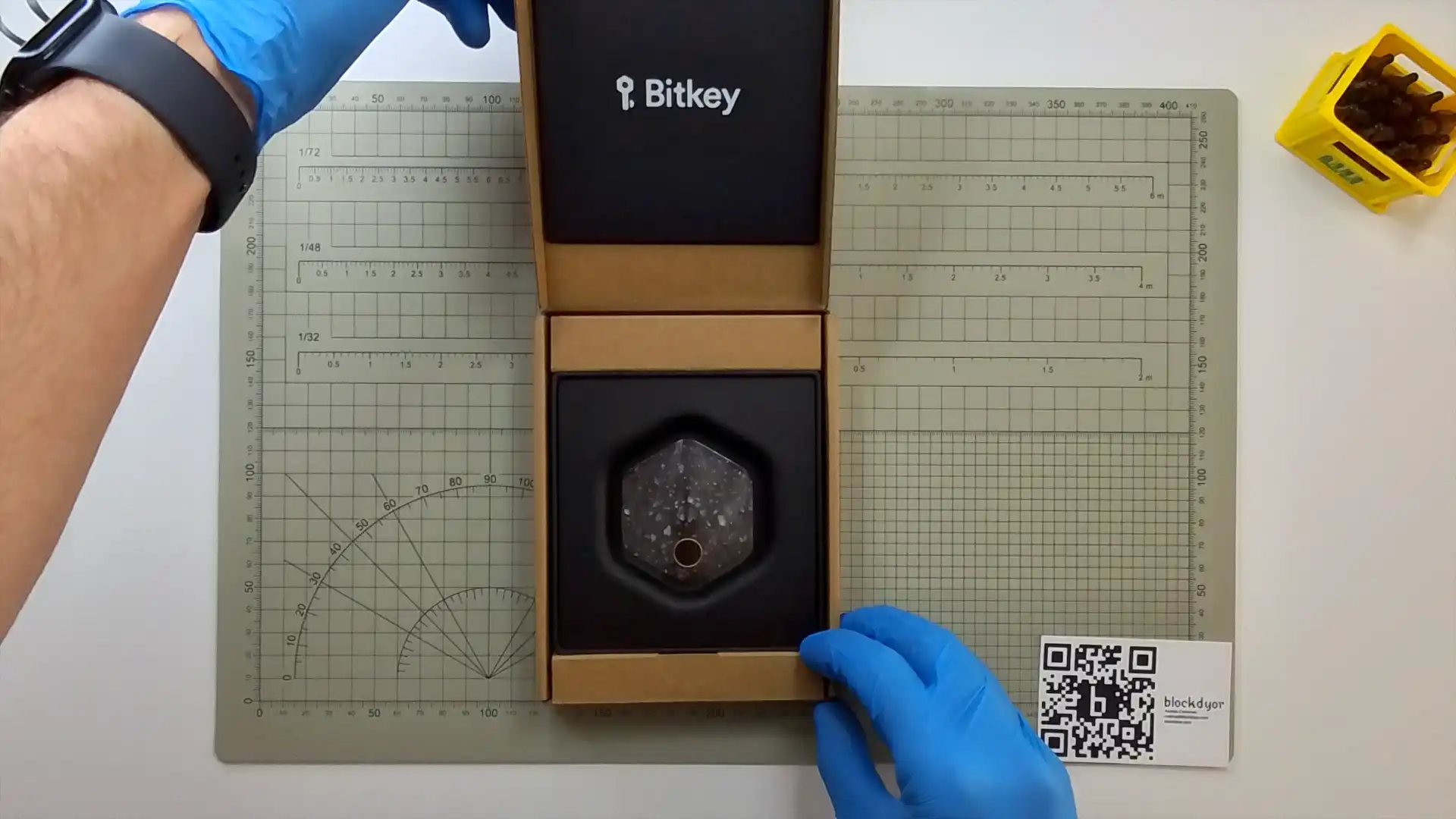
I purchased the Bitkey used for this review directly from the official Bitkey website. While it’s also available on Amazon, Best Buy, and a few other retailers, I’d really recommend buying it straight from Bitkey. First, you can use our discount code BITKEYBLOCKDYOR for 10% off the final price. More importantly, buying directly from the source reduces the chances of getting a device that’s been tampered with or passed through unknown hands.
After placing my order, the device arrived within a few days, even though it was an international shipment. It was delivered by FedEx, with no customs or import fees, packaged discreetly in a standard FedEx mailer and protected with internal bubble wrap.
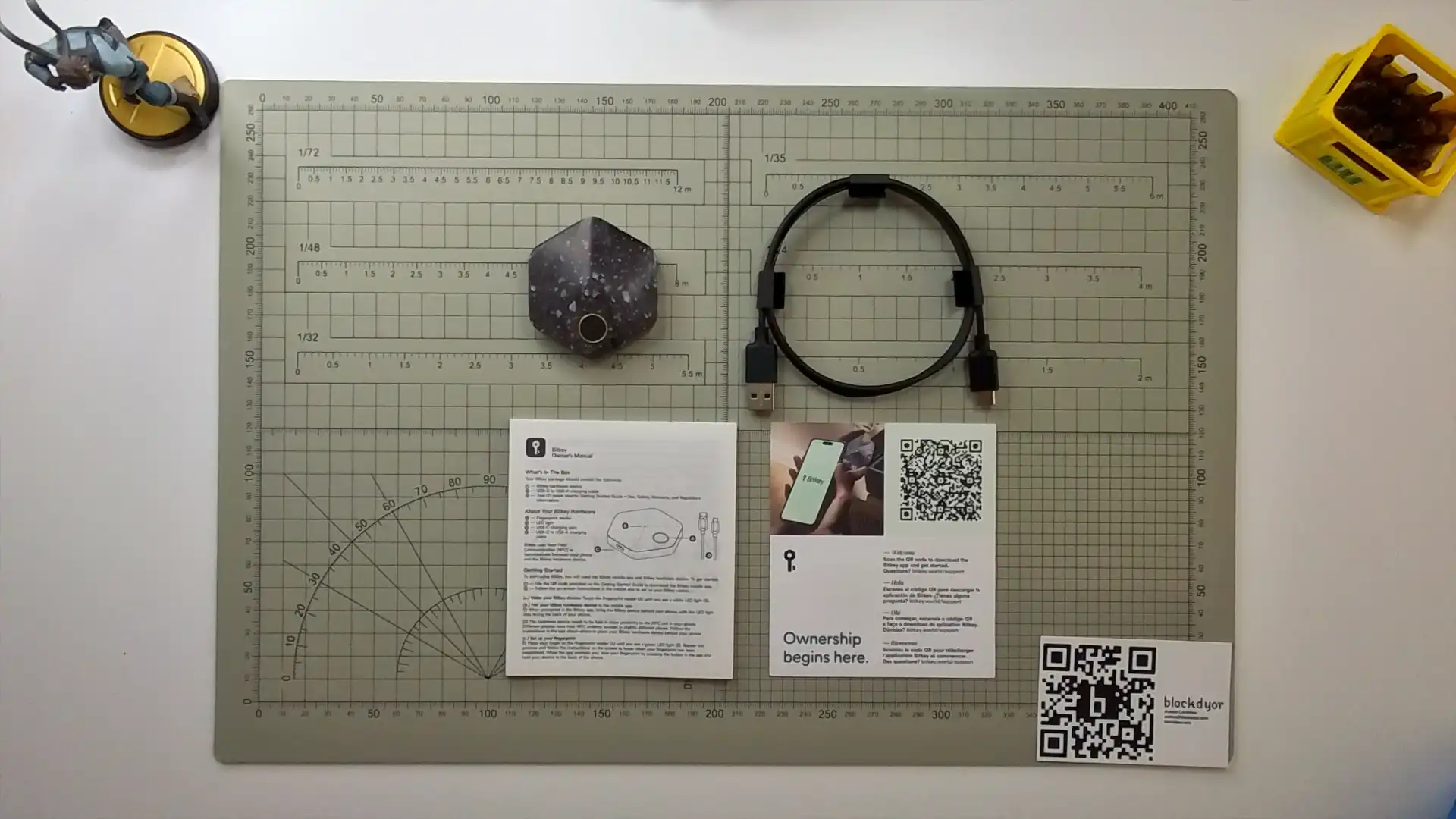
The Bitkey box itself is compact and thoughtfully designed. It serves both as shipping protection and as a reusable case for the device. Made from recycled paper, the package includes:
- 1x Bitkey
- 1x Charging cable (power only, no data)
- Instruction manual
- Quick start guide
Everything inside is minimal and straightforward, just as it should be. The first step, clearly emphasized in the included leaflet, is to download the app on your smartphone. That’s essential, since the hardware device alone doesn’t do much on its own, it’s just one of the three key elements in Bitkey’s multisig security model.
The device comes with a protective plastic film and should be fully charged before first use. Under typical conditions, the battery is expected to last about a year.
This first Bitkey hardware device is labeled on the back "Model BK001," which hints that future versions, like BK002, BK003, and beyond, might be on the horizon. Nothing’s confirmed, but it’s a possibility worth keeping an eye on.
Design and Build Quality

Bitkey’s hardware wasn’t just thrown together. It was designed in close collaboration with Tact, a product development and engineering firm known for working with names like Square, Logitech, HP, Brita, and others. Tact specializes in turning sharp design ideas into real, physical products. For Bitkey, that meant making something that felt intentional, durable, and honestly, a little striking.
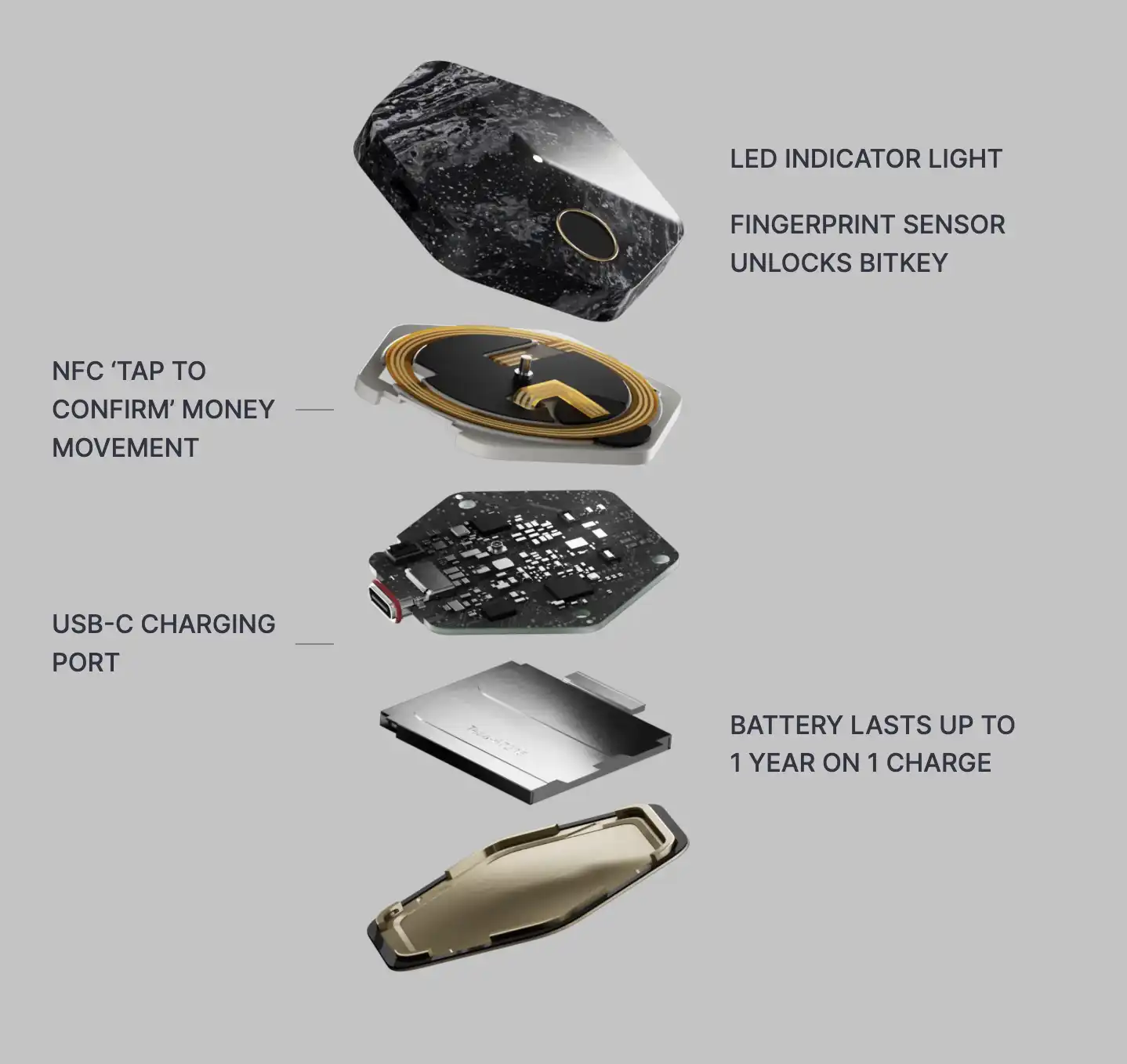
The early sketches imagined a cube turned at an angle, one corner pointing at you. The goal was to create a visual trick: a shape that looks like a hexagon rising into a pyramid, something that’s nearly impossible to sculpt in 3D without losing the effect. But they pulled it off. The result is a device that looks simple at a glance, but up close, reveals smooth transitions and sharp edges that catch the light like a jewel.
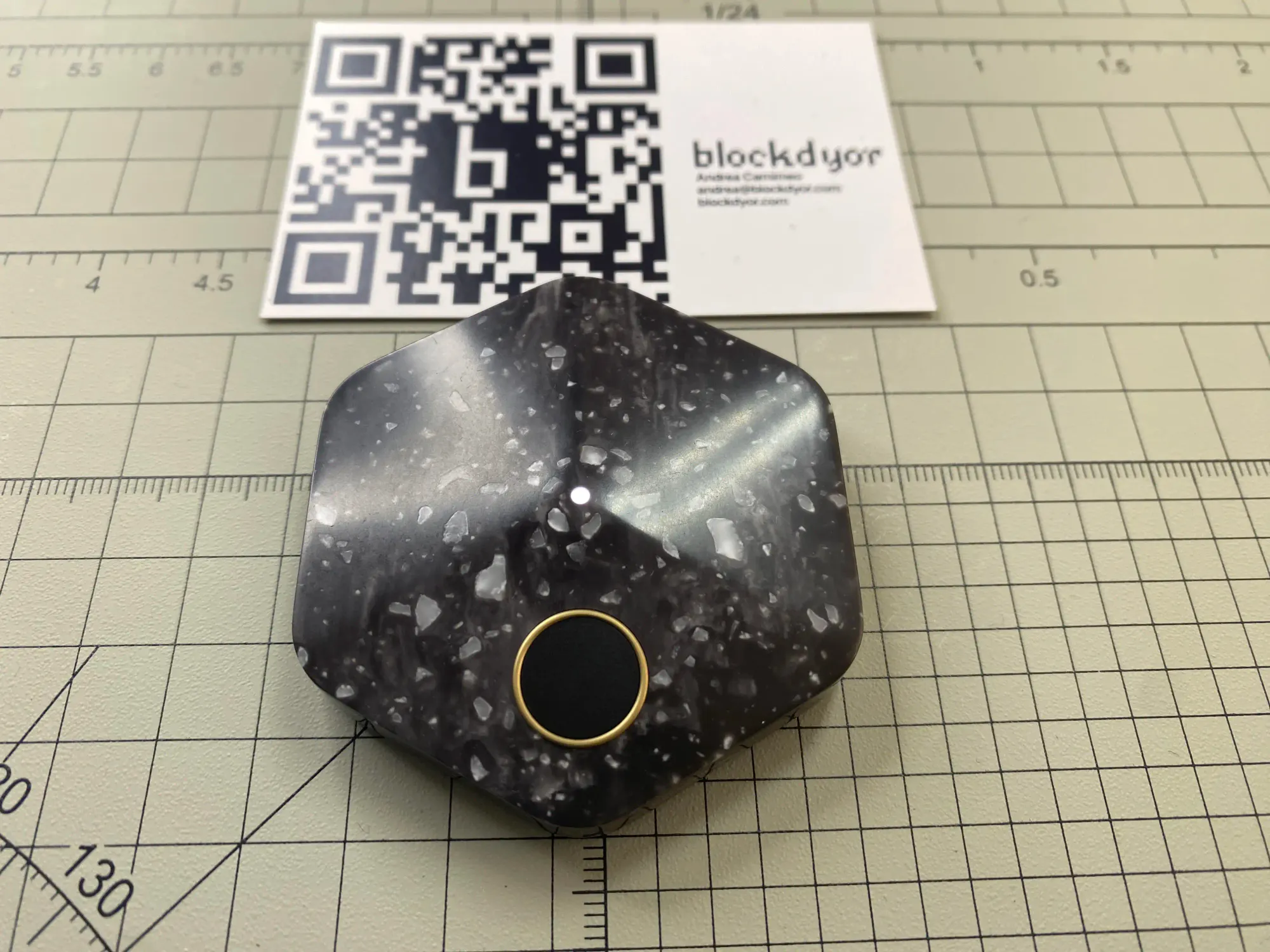
The front is made of Corian, a material typically used in high-end interiors, while the back is brushed gold stainless steel.
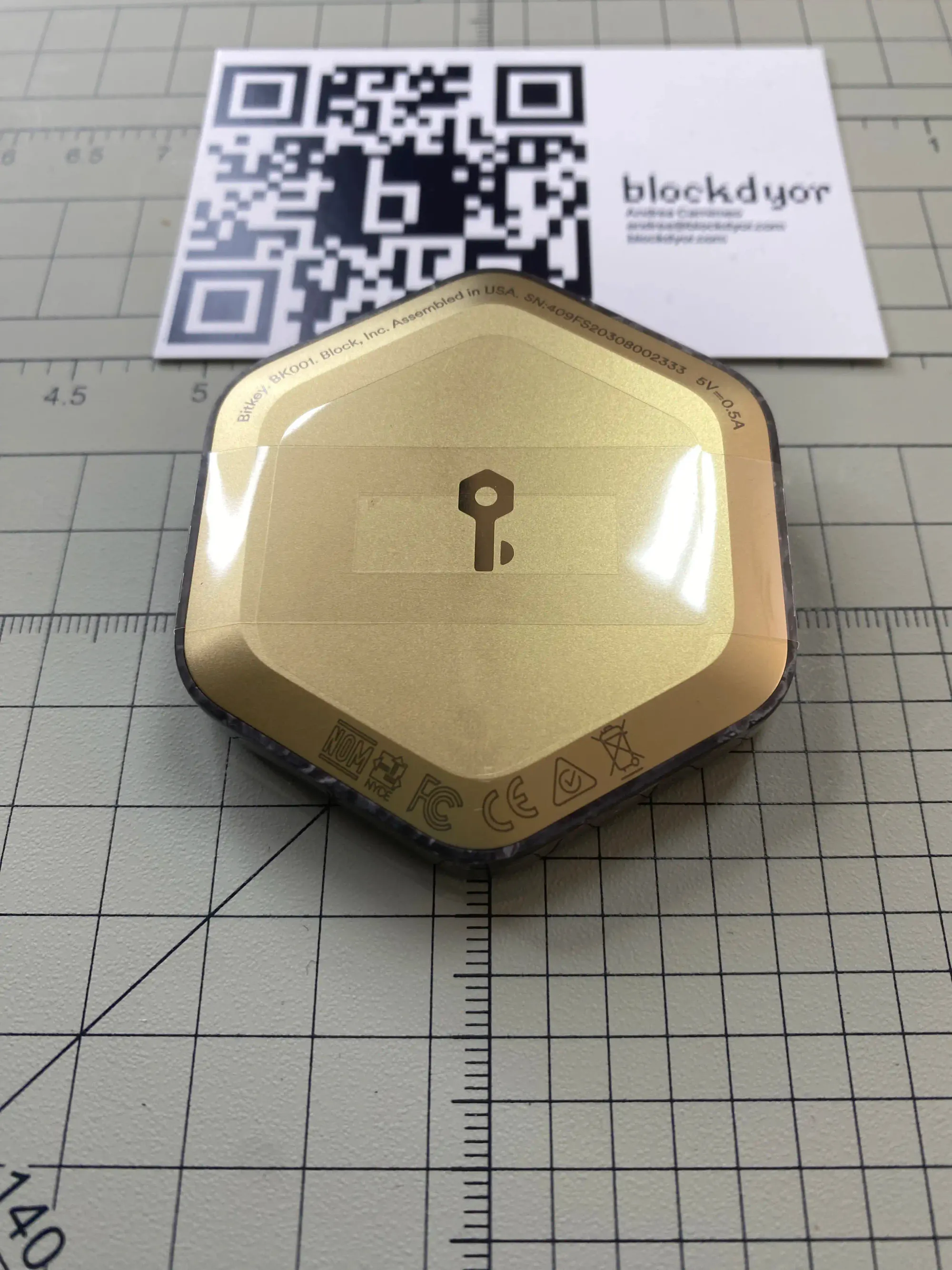
It features an engraved logo, the codename "BK001," serial number, voltage details, country of assembly (USA), and other information. It resembles as a stone and feels solid and premium, but never flashy. Just enough weight in the hand to feel like it matters.
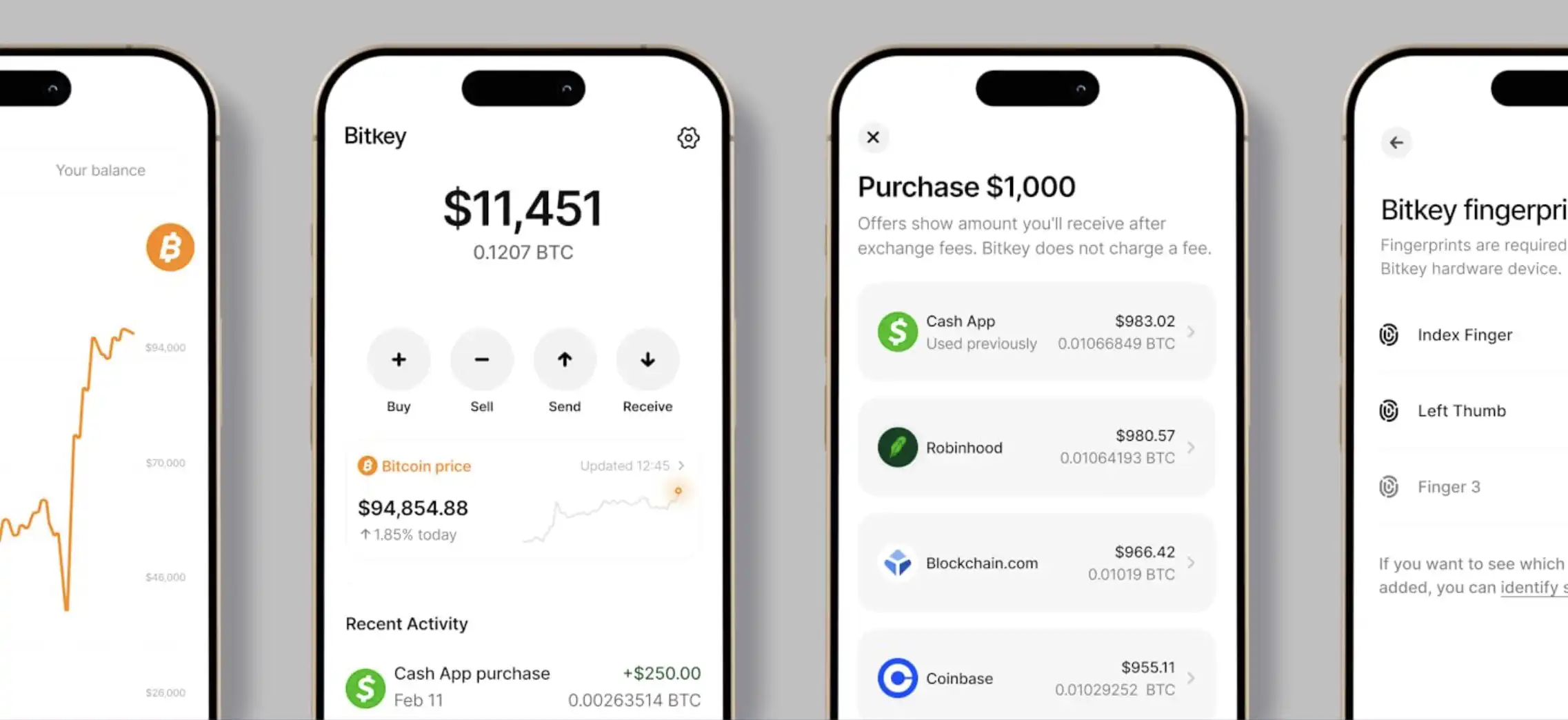
Still, Bitkey isn’t just the hardware. The app (available for iOS and Android) is its natural extension and it’s ridiculously easy to use, designed with just the essentials right on the home screen: send Bitcoin, receive Bitcoin, add Bitcoin.
And because the app is always evolving with the software updates, new features roll out without requiring a hardware upgrade. The physical device anchors your security, but the software keeps getting better over time.
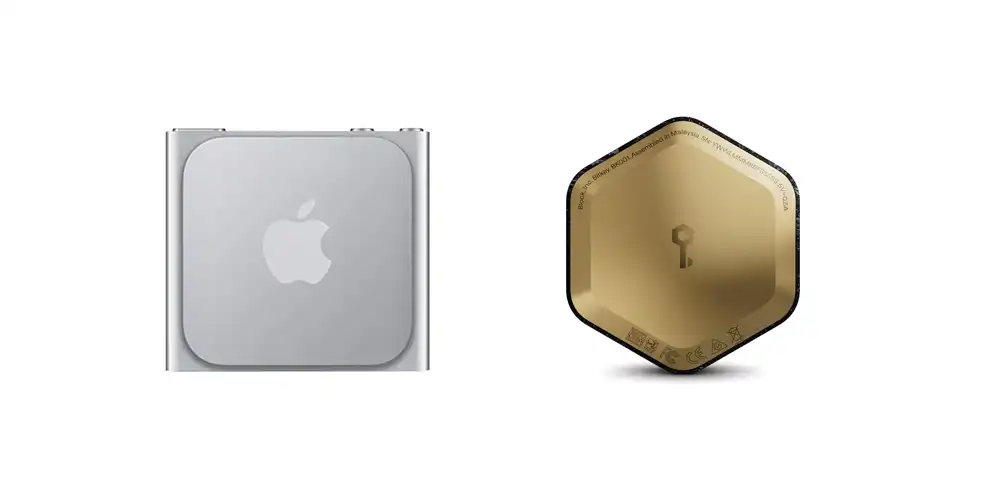
If someone told me Apple had quietly released a Bitcoin-only wallet and named it Bitkey, I’d honestly believe them. This thing carries all the industrial design cues you’d expect from the Jony Ive era. The premium metal finish, the quality materials, that engraved detail on the back, the single sleek port, and those clean, sloped, geometric lines. It all feels like something straight out of Cupertino.
Bitkey Quick Review
If you think I’m rambling a bit too much in this review, no worries. You can check out the quick summary instead, where we break down all the key points and rate each one as objectively as possible with our Blockdyor Score.
| Category | Feature | Score |
|---|---|---|
| 🔐 Privacy & Security (48/50) | ||
| 📄 Open Source Compliance | Fully FOSS under the MIT license, source code is public | 10/10 |
| 🔄 Firmware Integrity | Reproducible builds possible, binaries can be verified | 10/10 |
| 🔐 Secure Element | Uses a secure MCU (not a traditional SE), with PUF-protected key storage, TrustZone®, fault injection and side-channel countermeasures | 5/5 |
| 🌱 Seed Generation | Key generated securely on-device, but no dice roll or full entropy import support | 4/5 |
| 💾 Seed Storage | Multisig with keys split: device, phone, and encrypted cloud | 5/5 |
| 💼 Software Wallet | Only works with the Bitkey app (no third-party wallet support yet) | 4/5 |
| 💰 Purchase Procedure | Traditional payment methods or BTC | 5/5 |
| 📦 Packaging Safety | Tamper-evident packaging and secure unboxing | 5/5 |
| 🚀 Features (49/50) | ||
| 🖥️ User-Friendly UX | Clean UI on a bright screen, simple user flow | 5/5 |
| 🎨 Design & Build Quality | Solid construction with metal chassis, minimalist design | 5/5 |
| 📡 Air Gap / PSBT / SeedQR | No QR signing, not air-gapped, no PSBT support | 4/5 |
| 💾 MicroSD Backup | Does not support SD backup, but relies on encrypted cloud backup | 5/5 |
| 🤝 Multisignature Support | 2-of-3 with device, phone, and Block server (user controls 2) | 5/5 |
| 🔐 Passphrase (BIP39) | It's multisig, so no passphrase (13th/25th word) support | 5/5 |
| 🔌 Connection | USB-C port for charging only, no data, no wireless comms | 5/5 |
| 📦 Ready-to-Use Package | Comes with cable and everything you need to get started | 5/5 |
| 📚 Documentation | Solid public documentation and guides on GitHub and site | 5/5 |
| 🛠️ Customer Support | Active support via email and social channels | 5/5 |
| 🧱 blockdyor Score (97/100) |
How to Set Up The Bitkey
To begin using Bitkey, you’ll need both the Bitkey mobile app and the Bitkey hardware device. Here’s a quick overview to get up and running:
- Download the App: Use the QR code in the printed “Getting Started Guide” included in the box to download the Bitkey mobile app.
- Set Up Your Wallet: Open the app and follow the instructions. Here’s what the process looks like:
- Wake the Device: Tap and hold your finger on the fingerprint reader (marked A). When the white LED lights up, the device is active.
- Pair the Hardware Wallet: When prompted, place the Bitkey device behind your phone with the LED side facing the back of the phone.Make sure it’s close to your phone’s NFC antenna. The app will help guide you to the right spot.
- Register Your Fingerprint: Place your finger on the fingerprint reader (A) and wait for the green LED to light up.Repeat this a few times as instructed until your fingerprint is fully captured. When prompted, press the button in the app and again hold the device behind your phone to save it.
- Finish Setup: Follow the remaining on-screen steps to complete the wallet setup.
Bitkey User Interface
Once finished the setup you will see the Bitkey App User Interface, let's see how it's structured.
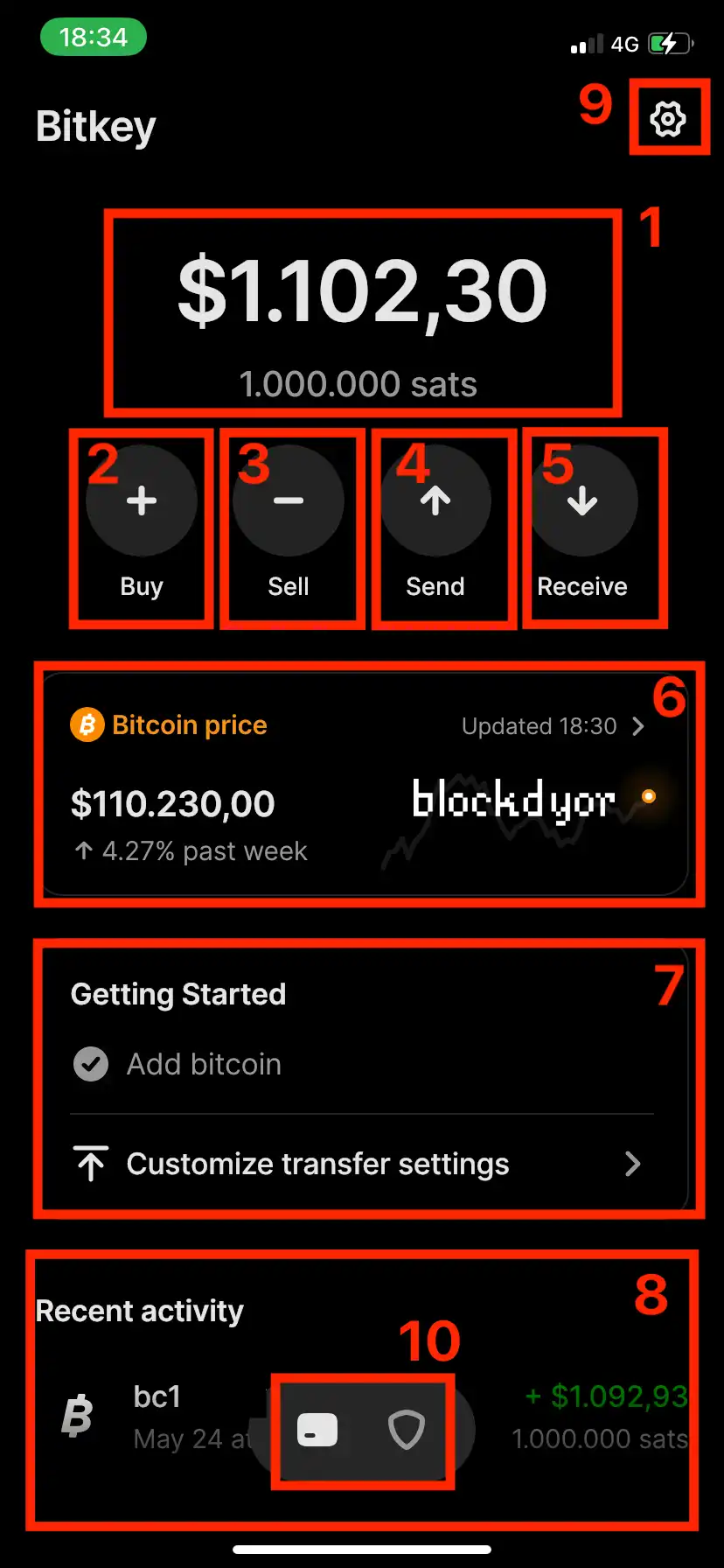
- Wallet Balance: Shows your total Bitcoin balance in fiat and sats.
- Buy Button: Lets you purchase Bitcoin using fiat.
- Sell Button: Allows you to sell Bitcoin for fiat currency.
- Send Button: Used to send Bitcoin to another wallet address.
- Receive Button: Generates a Bitcoin address or QR code to receive sats.
- Bitcoin Price Widget: Displays the current BTC price and recent price change. It also shows the gain/loss since when you received your coins.
- Getting Started Section: Guides new users through initial setup steps.
- Recent Activity: Shows a log of your most recent Bitcoin transactions.
- Settings Icon: Opens the app settings for preferences and security options.
- Menu bar: Displays buttons to switch from the main view to the security view.
How to Send/Receive Bitcoin with the Bitkey
To send bitcoin, you’ll need a bitcoin address from the person or service you’re sending it to. Bitkey makes this simple, whether you’re pasting in an address or scanning a QR code.
Sending BTC
Option 1: Using an address
- From the Bitkey app home screen, tap Send.
- Paste the recipient’s bitcoin address and tap Continue.
- Enter the amount you want to send. Tap the ↑↓ arrows to toggle between sats, BTC, or fiat.
- To send your entire balance, tap Send Max.
- If you’re sending to yourself, see the section on How can I consolidate my UTXOs?
- If your daily transfer limit is exceeded, the app will prompt you to use your Bitkey device.
- Review all details: address, amount, fees, and estimated confirmation time.
- Once everything looks good, tap Confirm.
- If required, finish the process by approving with your Bitkey hardware device.
Option 2: Scanning a QR code
- From the Bitkey app home screen, tap Send.
- Tap the QR code icon in the upper right corner to scan.
- Enter the amount to send. Use the ↑↓ arrows to switch units.
- You can also use Send Max to transfer your full balance.
- Just like before, if you’re over your transfer limit, the app will prompt for your Bitkey device.
- Double-check all transaction details, then tap Confirm.
- Use your hardware device if required to finalize the transfer.
Receiving BTC
You can receive bitcoin into your Bitkey wallet either from another wallet, an exchange, or an integrated partner (if available in your region).
- From the Bitkey app home screen, tap Receive.
- Choose one of the following:
- If integrated partners are available, tap one to follow their instructions.
- To receive from another exchange or wallet, tap Another exchange or wallet.
- You’ll see a QR code and your Bitkey wallet address. Share either with the sender.
- Once the transaction is broadcast to the Bitcoin network, it will show as pending on your Bitkey home screen and will update once confirmed.
Bitkey Review: Supported Coins
As Henry Ford famously said, “Any customer can have a car painted any color he wants, so long as it is black.” Jack Dorsey gave that a modern twist: “Any customer can have a Bitkey supporting any crypto he wants, so long as it’s Bitcoin.”
All jokes aside, Bitkey is strictly a Bitcoin (BTC)-only wallet. And that’s not a limitation, it’s a deliberate choice. As of now, it supports only on-chain BTC. This means lightning is not supported.
We’ve been saying for a long time that Bitcoin-only isn’t a drawback, it’s a benefit. Supporting just Bitcoin means no distractions from questionable tokens, no clutter from crypto projects with shady histories, and a much smaller codebase to secure. That translates to fewer bugs, a simpler interface, and a smoother, safer experience overall.
Bitkey Discount Code (10% OFF!)
If you’re looking for a Bitkey discount code to purchase at a price lower than retail or even Amazon, you’re in the right place. blockdyor offers an exclusive promo code:
BITKEYBLOCKDYOR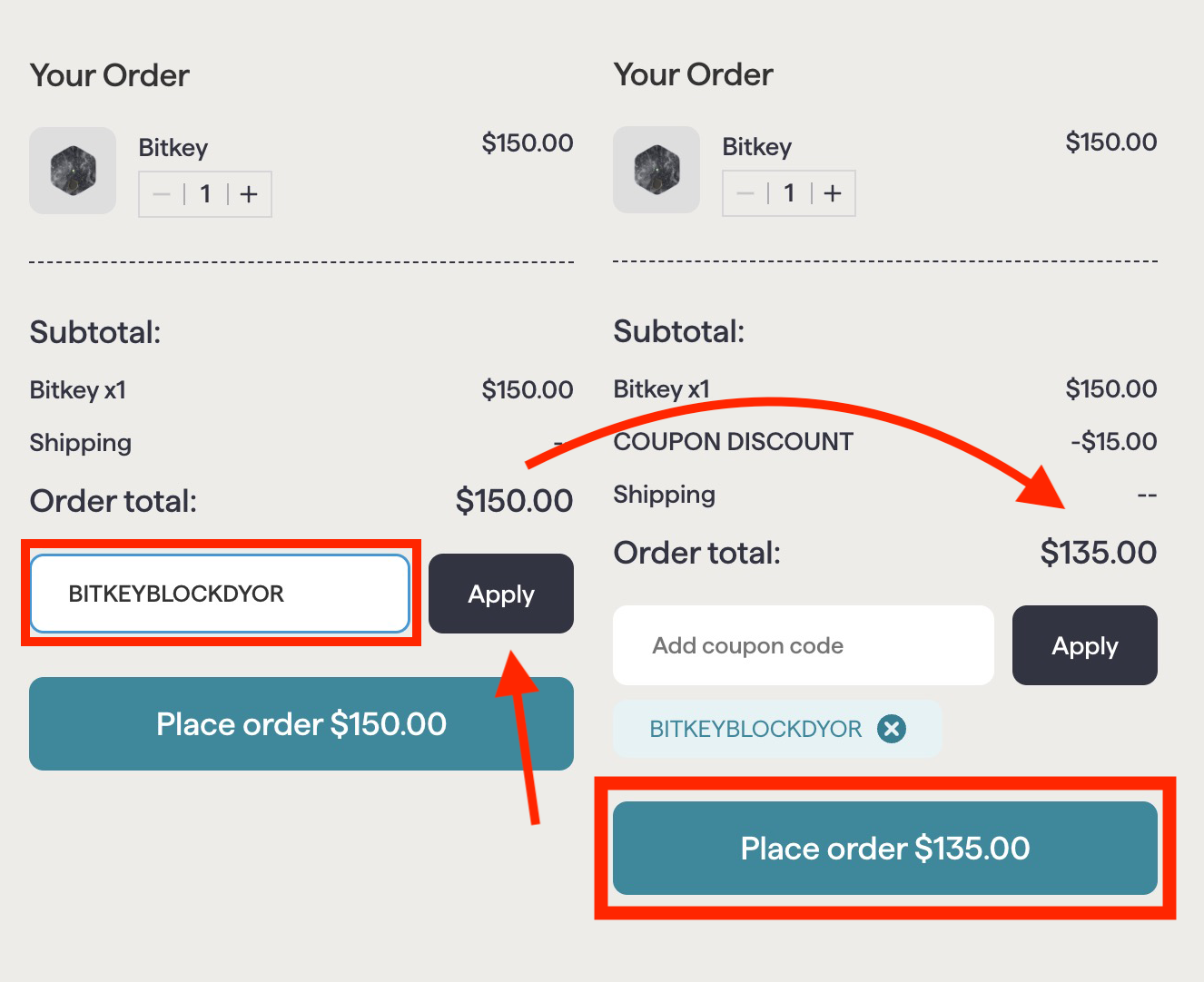
Simply enter this code at checkout on the official Bitkey website: bitkey.world.
Shipping is available worldwide, and all import taxes and customs duties are included in the final price.
👉 Click here to get the Bitkey. Use code BITKEYBLOCKDYOR at checkout for an exclusive 10% discount.
How to Buy the Bitkey
If you’re based in the United States or Canada, you can purchase Bitkey from the official Bitkey website, Amazon, or Best Buy. For international customers, Bitkey is currently available exclusively through the official website at bitkey.world.
The safest and most reliable option is to order directly from Bitkey’s official site. This ensures the device comes straight from the source, with no third-party resellers involved. Plus, you can apply the exclusive 10% discount using the code BITKEYBLOCKDYOR at checkout.
Now, let’s walk through the step-by-step process to buy your Bitkey and apply the discount for a significantly reduced price.
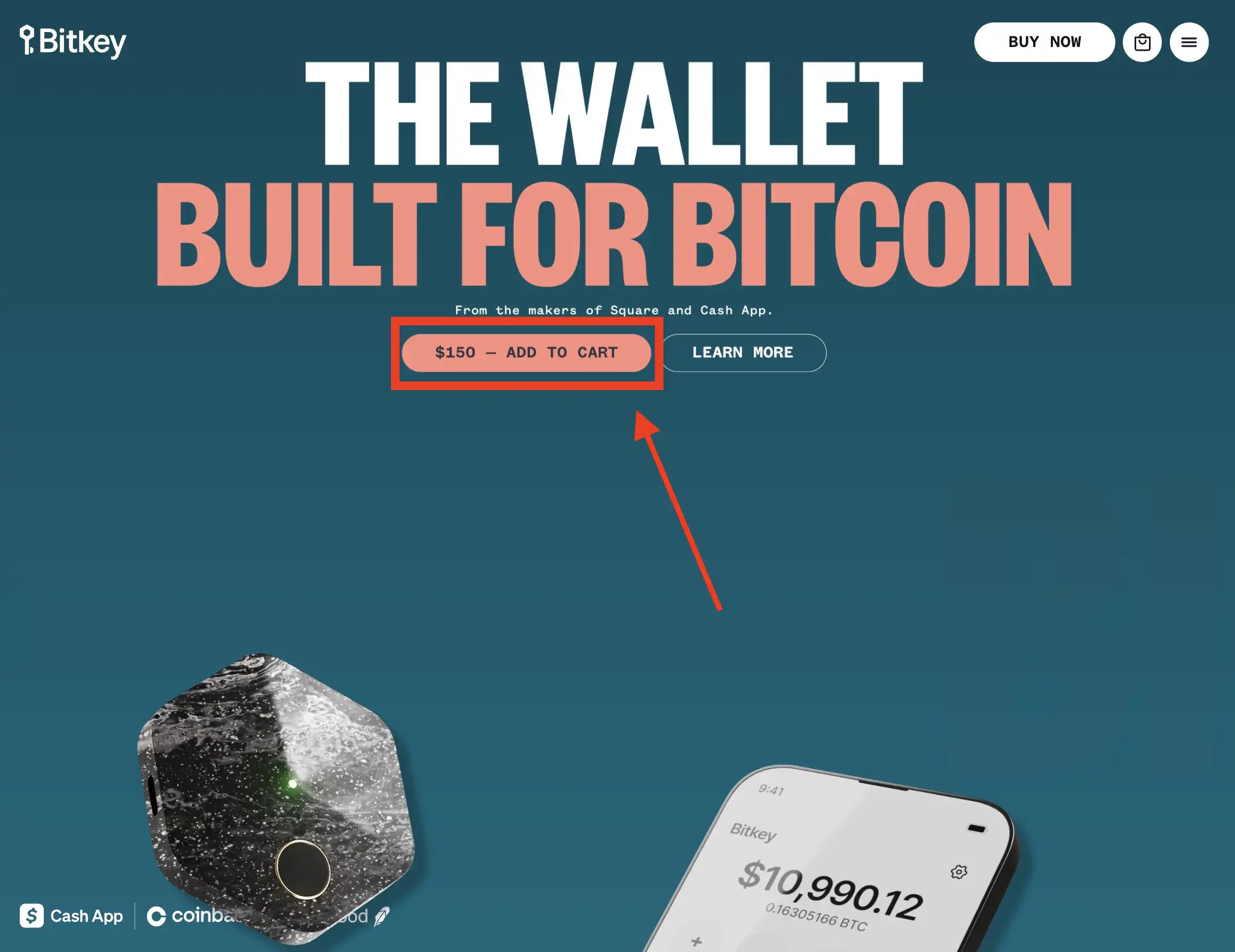
After clicking on the link you will be redirected to the bitkey.world official page. Click on "Add to cart" to go to the checkout page.

Click on the "Checkout" button.
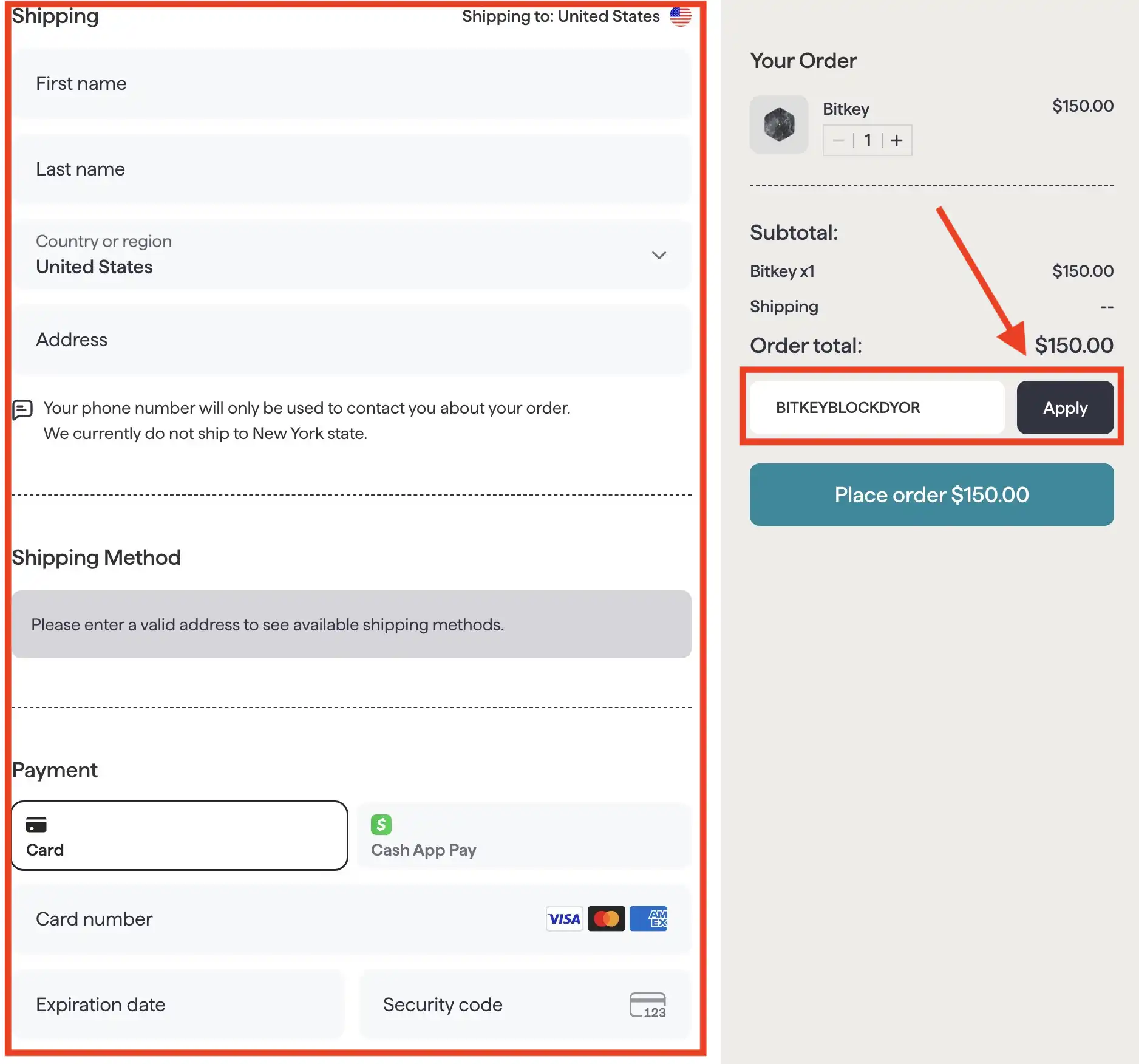
Enter your shipping and payment information, and don’t forget to apply the discount code BITKEYBLOCKDYOR to get 10% off your Bitkey purchase. You can pay with any major card, including Cash App Pay, and Bitcoin support is expected soon. Shipping is free, and all customs duties are included in the final price.
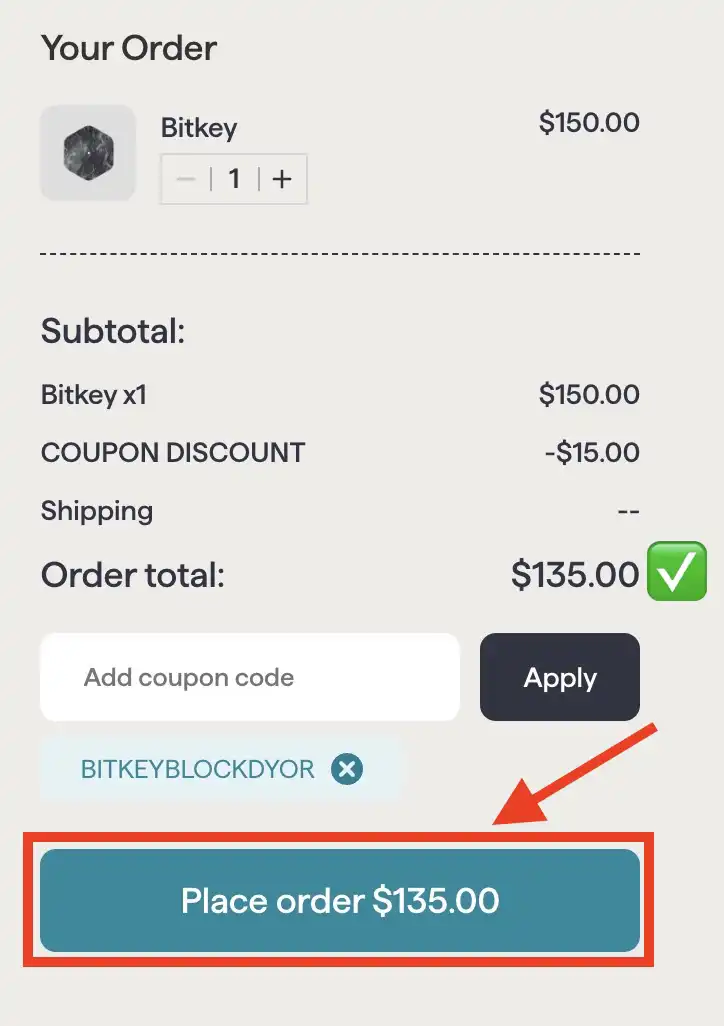
Once you click “Apply,” the total will update to reflect the 10% discount. Then, select “Place Order.” Within a day or so, you’ll receive a tracking number for your shipment, and your Bitkey should arrive within a few days.
Is the Bitkey Secure?
Both online and in-person, I’ve heard two recurring concerns about Bitkey’s security model. Let's dissect them:
- Two out of three keys aren’t cold storage: This is technically true. Only the hardware device key is fully cold. The app key and server key are considered “warm,” as they’re stored (encrypted) in software environments. However, this is a deliberate tradeoff to make Bitkey incredibly easy to use. In the worst-case scenario where both the app and server keys are compromised, Bitkey automatically triggers a 7-day security delay before any recovery can proceed. You’ll also receive alerts via SMS or email to confirm that you actually initiated a recovery request (delay + notify). It’s worth noting that even though wallet recovery can be done without the hardware (for situations where it’s lost), all outgoing transactions by default still require confirmation using your Bitkey hardware device. This adds a strong layer of protection. For more flexibility, users can enable a daily transfer limit to approve small transactions without needing the hardware each time.
- The hardware device has no screen: This is a common critique. It’s true that the hardware part of Bitkey doesn’t include a display, but the mobile app, which is an essential part of the setup, does. Bitkey argues that small screens on traditional wallets can offer a false sense of security. Malware can alter transaction data before it ever reaches the screen, which makes manually checking addresses ineffective. Instead of relying on screen-based verification, Bitkey uses cryptographic verification between the hardware, mobile app, and server to provide stronger protection.
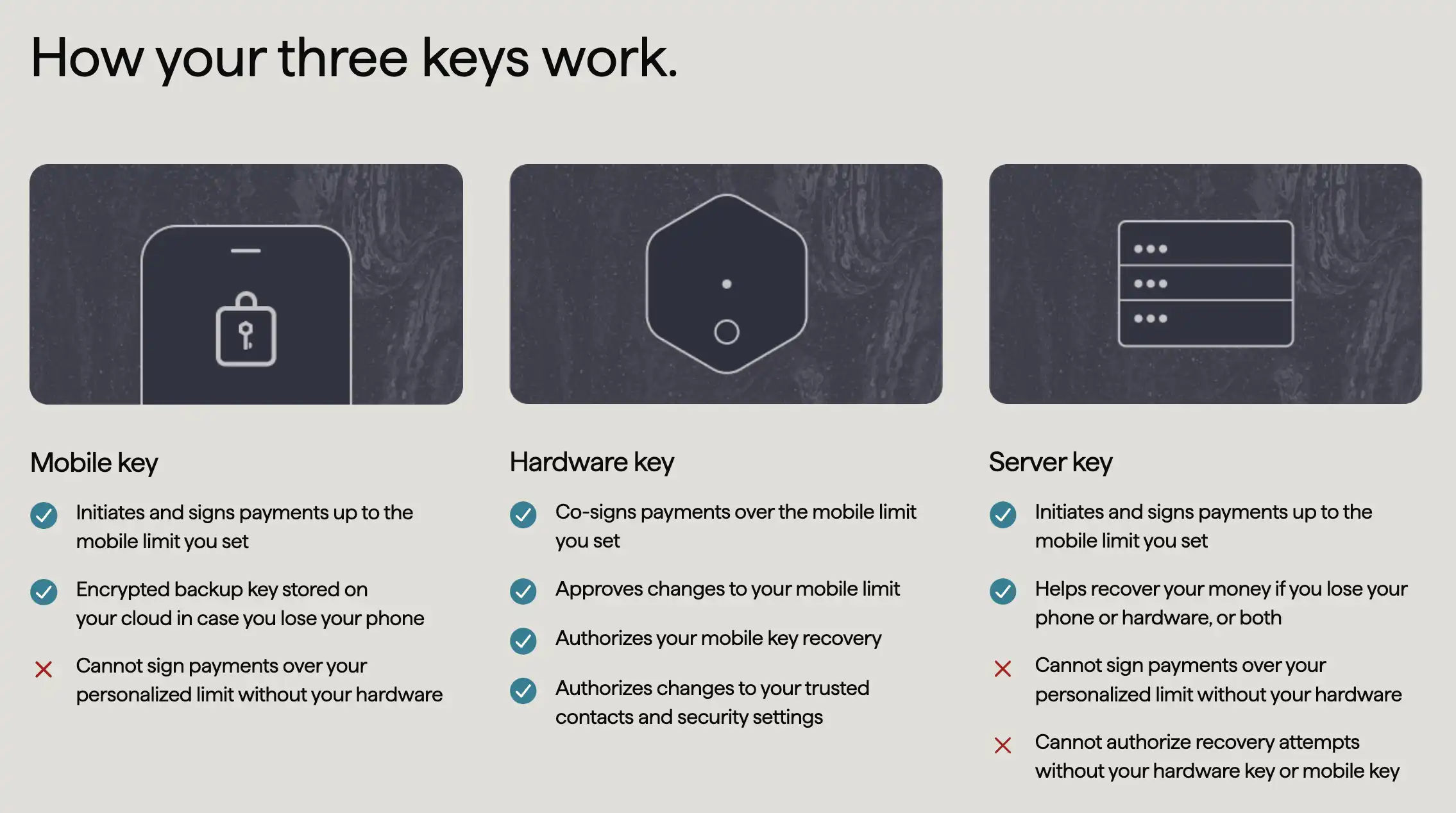
So, is Bitkey really secure?
Yes, and here’s why: Bitkey is a multisig wallet by design, meaning there’s no single point of failure. That’s a huge advantage over single-signature wallets, where your entire security often depends on a seed phrase written on paper (single point of failure).
With Bitkey, there are no PINs to memorize (otherwise it would be another single point of failure), just a fingerprint to unlock the hardware. You also have multiple recovery options in case your phone or device is lost, including social recovery and inheritance support, all at no extra cost.
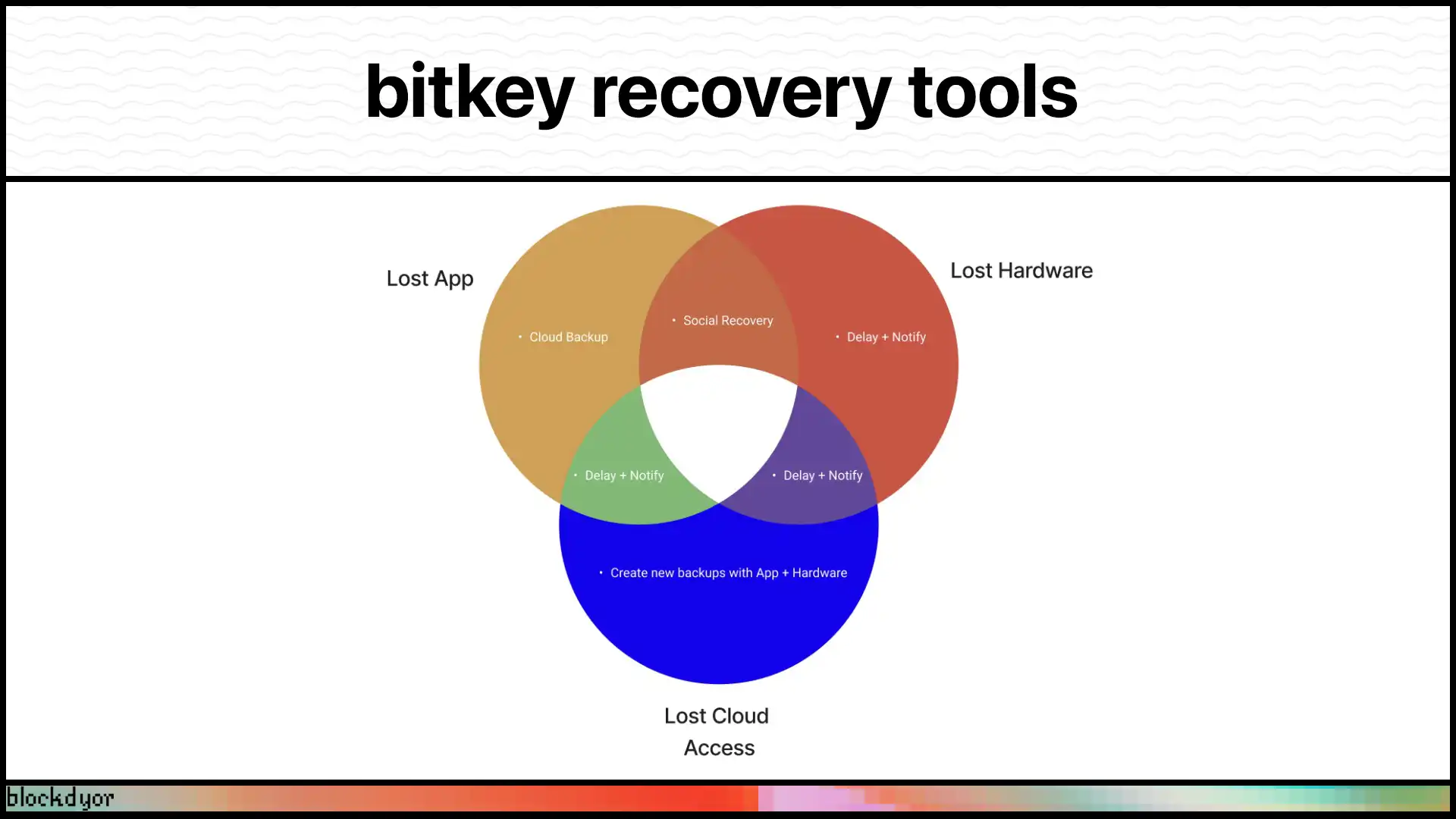
And above all, the simplicity of Bitkey makes it far more secure for the average person. It’s harder to mess up, easier to use, and far less likely to lead to lost funds, which, in the end, is what matters most. In short: the whole ecosystem makes it almost impossible to lose your bitcoin.
The cloud backup, which holds one-third of the key on Bitkey’s servers, might look like the weak spot in the system. Storing any part of a backup in the cloud can feel risky. However, it’s important to note that these cloud backups are encrypted with keys only the customer’s phone and hardware device know. So, even if the platform could access the backups, they’d still be encrypted and unusable.
This is really handy because the most common issue is losing, damaging, or replacing your phone, which means you can’t access the Bitkey app anymore. In these cases, the Bitkey system makes recovering your bitcoin straightforward. Just install the Bitkey mobile app on your new phone and log in with the cloud account you used to create your wallet. The app will guide you to unlock and tap your hardware device to regain access.
Data Privacy
When it comes to data privacy, Bitkey takes some meaningful steps forward, especially compared to typical custodial wallets or even many mainstream hardware wallets.
One standout feature is support for connecting your own Electrum server. That means you don’t have to leak your transaction data to third-party servers when checking balances or broadcasting transactions. But there’s a catch: Bitkey only allows Electrum connections over HTTPS, which adds encryption but also disqualifies most default Umbrel setups that still rely on plain TCP. It’s a smart move from a privacy standpoint, but it does create a hurdle for some self-hosters. If you want to make the most of this feature, you’ll need to configure your Electrum server with a proper HTTPS setup (probably better doing so with StartOS). Otherwise, you can export the XPUB of your wallet to Sparrow Wallet and watch it from there.
That said, Bitkey doesn’t currently support CoinJoin or any built-in transaction obfuscation methods (and not even any type of coin control). So, while it protects your privacy on the network layer by letting you avoid using their default backend, your on-chain footprint is still completely transparent. Block, the company behind Bitkey, even acknowledges that it can identify Bitkey-originating transactions due to its involvement in the signing process. To their credit, they’ve implemented strong internal controls around data access, with access only permitted in limited scenarios by an on-call team and an approval process. But the potential visibility still exists.
Importantly, even if Block is served with a legal request, they cannot move your funds. Bitkey uses a 2-of-3 multisig model, and Block holds only one key. Without one of your keys, they’re stuck. That design means your coins can’t be seized just by flipping a switch, and that’s not just a policy, it’s baked into the tech.
Open-Source Firmware
We've published Bitkey's source code since we launched a year ago, so anyone could see how it works and use it for non-commercial purposes.
— ₿ENOWHERE (@BEN0WHERE) May 1, 2025
Now, we're moving to a fully open-source license. Tell us what you want to build with it.https://t.co/w6hZ2VRn6G https://t.co/7of4kgHp3d
Bitkey didn’t open source everything at launch, but did it more or less one year later with a nice surprise for developers and Bitcoin enthusiasts. In 2025, Block, Inc. released the core software under the MIT License: a highly permissive free software license that allows anyone to use, modify, distribute, or even sell the software, as long as the original license and copyright notice are included.
Secure Seed Generation
Bitkey doesn’t use a traditional seed phrase (BIP39) in the way most wallets do, and while the full technical details of its entropy generation haven’t been made public, key parts of the process can be inferred. The hardware wallet uses a secure microcontroller that includes a Physically Unclonable Function (PUF). This allows it to generate a unique hardware-derived key each time the device powers on, without ever storing that key in memory or flash.
The private key itself is encrypted with this PUF-derived secret and stored securely on the device. This setup ensures that even with full physical access, extracting the raw key is extremely difficult. Combined with a standard hardware random number generator and a multisig model that separates keys across the device, phone, and cloud, Bitkey provides a secure and modern approach to entropy and key management, without relying on a visible seed phrase.
Safe Seed Storage
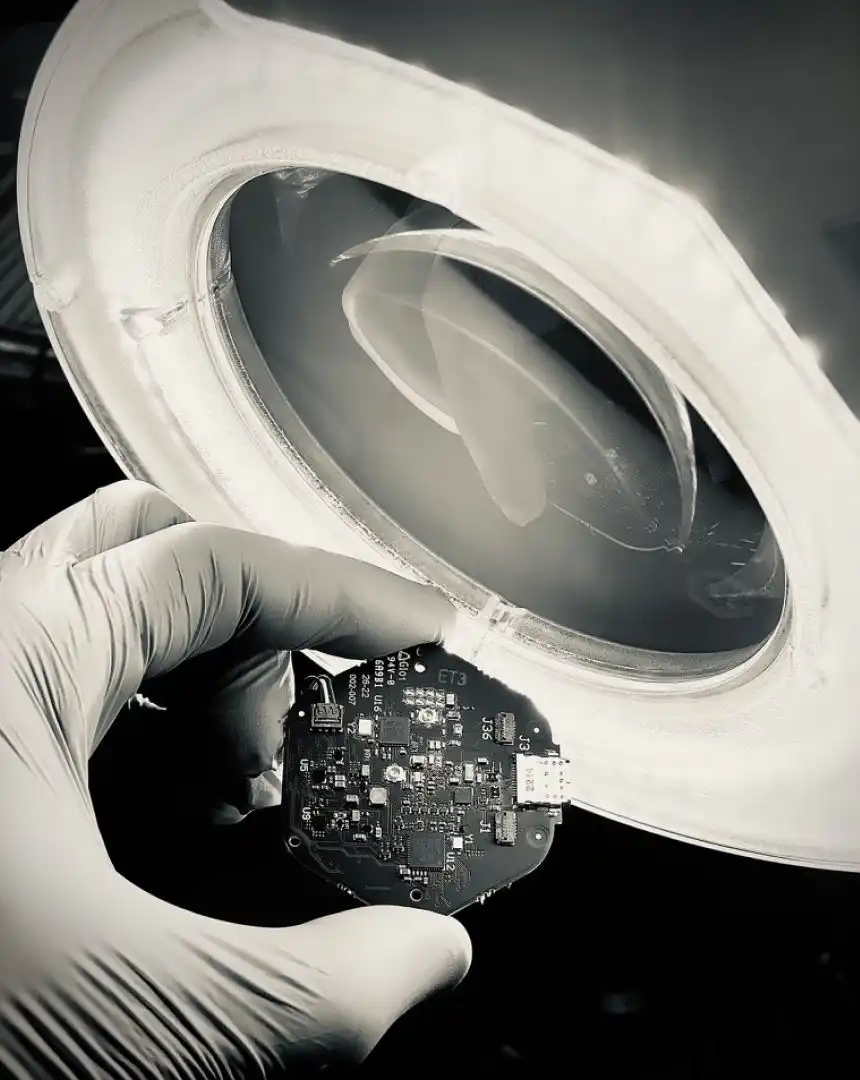
Bitkey secures the private key using a secure microcontroller, the Silicon Labs EFR32MG24. This chip includes a Physically Unclonable Function (PUF), which creates a secret key from the unique physical properties of the silicon. That secret is not stored anywhere. Instead, it’s re-generated every time the device powers on. Bitkey encrypts the user’s private key with this PUF-derived key and stores only the encrypted version. Since the root key doesn’t exist while the device is off, it’s extremely difficult to extract the private key even with full physical access.
The chip also enforces secure boot, isolating sensitive code using ARM TrustZone, and includes protections against side-channel and fault injection attacks. Compared to traditional Secure Elements, this secure MCU gives Bitkey more control over firmware and lets them open-source it. That transparency is a core part of the design. Instead of locking critical logic behind NDAs, Bitkey can publish and audit the code, which strengthens trust and security over time.
Firmware Verification
One of the most important elements of this transparency is Bitkey’s commitment to reproducible builds. This means anyone can take the source code published on GitHub, build the app themselves, and verify that the resulting software matches the official version available in the app stores. This process provides strong guarantees that the published code is the same one customers are actually running, eliminating blind trust.
Bitkey’s open development model encourages independent review and allows external contributors to report bugs or vulnerabilities. All of this reinforces user control, aligns with the values of self-custody, and sets a high bar for accountability in hardware wallet development.
Bitkey Price and Value for Money
Imagine a device that looks like Steve Jobs and Jony Ive teamed up with Satoshi for a design session. Now imagine it runs open-source software that somehow manages to pull the best from both the hardware and self-custody worlds, while following Bitcoin ethos. If you told me that this thing costs just $150, I’d probably wouldn't believe it.
But here we are. Bitkey delivers an experience that feels premium from start to finish. And it’s not just about how it looks or feels, some features that competitors charge for are completely free here. For example, inheritance planning, which costs $480 per year with something like Nunchuck’s Honey Badger multisig, is included at no extra cost.
What makes it even better is that it works for all kinds of users. This, in fact, isn’t just a device for beginners. It’s built to be simple to use while also giving more advanced users what they need, like the option to connect to your own Electrum server. And with the app constantly getting new features through regular updates, the value just keeps growing.
Bitkey Pro Alternatives
Right now, Bitkey is the only self-custody hardware wallet ecosystem that’s been designed from the ground up with multisig. That’s what makes it stand out. You can’t just buy three separate hardware wallets and set up a 2-of-3 multisig with a software wallet like Sparrow or BlueWallet and expect the same level of ease of use or recoverability.
In a different 2/3 multisig, if you lose two devices and you don't have a collaborative custody party (like in this case the cloud key with Bitkey), so your Bitcoin is gone for good.
Bitkey solves this by not only by using multisig, but by including a third-party key as a backup. It’s what’s called collaborative custody. You hold two of the three keys, and the third is managed by Bitkey, only used in emergencies.
| Feature | Bitkey | Nunchuck Honey Badger |
|---|---|---|
| Multisig Setup | 2-of-3 | 2-of-4 |
| Key Holders | You (2 keys) + Bitkey (1 cloud key) | You (2 keys), Inheritance key, Nunchuck (1 key) |
| Custody Model | Collaborative custody | Collaborative custody with inheritance planning |
| Recovery Support | Emergency Access Kit (offline, no servers) | Cloud backup + Nunchuck-assisted recovery |
| Inheritance Planning | Included | Included |
| Hardware Wallet Support | Bitkey device only | Supports multiple hardware wallets |
| Annual Cost | One-time purchase (no ongoing fees) | $480/year |
| Extra Features | Social recovery, encrypted backups | Scheduled txs, key health checks, spending limits |
| Emergency Use Fee | None | 0.1% if inheritance key is used |
| Open Source | Yes | Yes |
Nunchuck’s Honey Badger: this plan by the renowned Bitcoin-only multisig company Nunchuck offers a 2-of-4 multisig setup: two keys are for daily use, one is reserved for inheritance, and one is held by Nunchuck for backup. It costs $480 per year and includes features like inheritance planning, cloud backup, hardware wallet support, health checks, automated key replacement, spending limits, scheduled transactions, and emergency lockdown. A 0.1% fee may apply if the inheritance key is ever used. You can try it free on testnet.
Bitkey Pros & Cons
In its first year, Bitkey fixed two major gaps: it’s now fully open source, and it supports inheritance planning. It’s still a relatively young product, and some more advanced features are missing, like the ability to use 3rd party software wallets & other little things, but despite that, it’s already far more usable and practical than most of the competition. Now that the code is open to outside developers, chances are good these remaining issues will be addressed in time.
| Pros | Cons |
|---|---|
| ✅ Very hard to lose access thanks to the full Bitkey setup | ❌ Doesn’t support third-party wallets |
| ✅ Simple and beginner-friendly | ❌ No coin control or even just labeling of UTXOs |
| ✅ Multisig built in by default | ❌ Hardware device has low reparability |
| ✅ Excellent value for money | ❌ Still missing a few advanced features |
| ✅ Sleek and well-thought-out design | |
| ✅ Built-in spending limits for extra safety | |
| ✅ Free inheritance planning included |
TIME’s list of Best Inventions (2024)
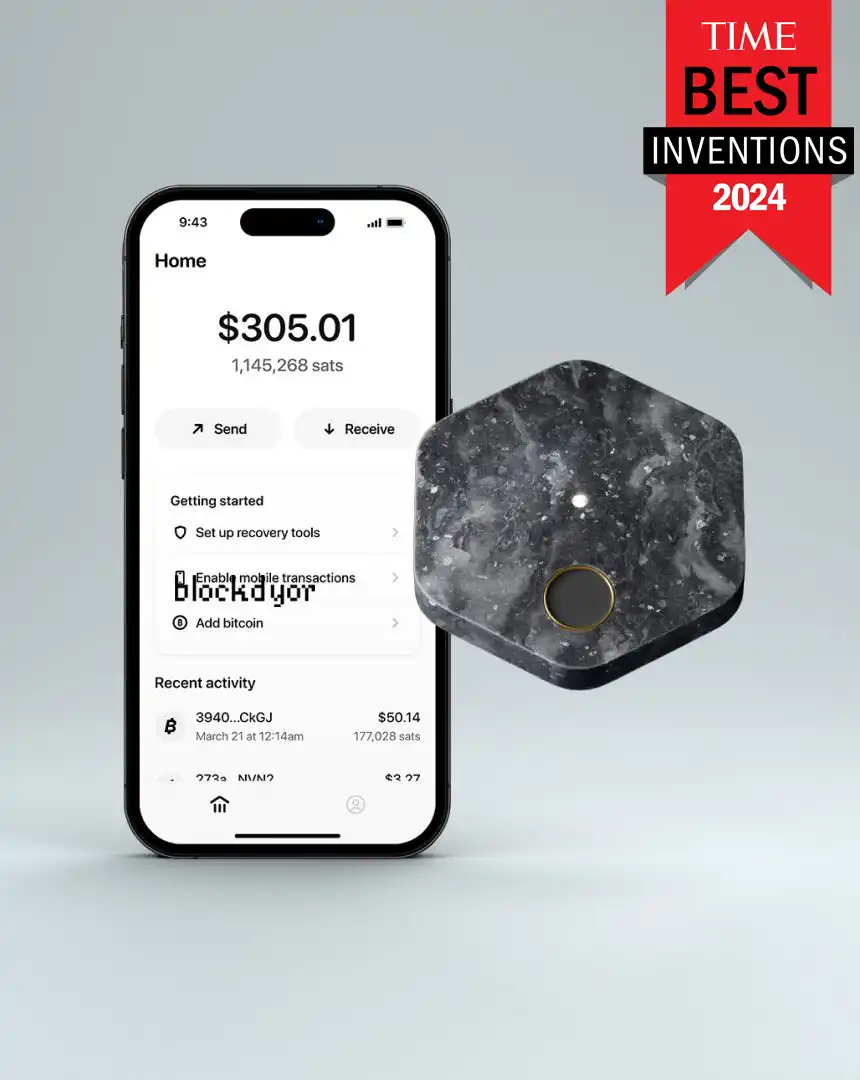
Until Bitkey, no Bitcoin or crypto wallet had ever received a major award, especially not from TIME. That changed in 2024, when Bitkey was named one of TIME’s Best Inventions in the Privacy & Security category.
For over twenty years, TIME has highlighted products and ideas it considers truly impactful. Bitkey is now part of that short list. The recognition places it alongside technologies that are not only new, but meaningful, tools that shift expectations and influence what comes next.
In describing this year’s list, TIME editors wrote:
“The result is a list of 200 groundbreaking inventions (and 50 special mention inventions)—including the world’s largest computer chip, a humanoid robot joining the workforce, and a bioluminescent houseplant—that are changing how we live, work, play, and think about what’s possible.”
Bitkey didn’t just win an award. It set a precedent. And the fact that it’s a Bitcoin-only wallet, not some generic crypto app, makes the recognition all the more meaningful. That’s pure signal.
Bottom Line
After spending years here on blockdyor testing almost every hardware wallet that’s come to market, a pattern became impossible to ignore. Most of them blur together. They rely on the same basic singlesig setup, offer the same set of features, and end up feeling like slight variations of the same idea. Reviewing some of them started to feel repetitive.
But Bitkey stood out immediately. There’s a certain quiet confidence to it. Where some others feel like unfinished thoughts, copies of each other or half-built prototypes, Bitkey feels resolved. Complete. It’s not just functional, it’s considered.
You get the sense that someone spent a long time removing everything unnecessary until only the essential was left. And more than that, they made it feel easy. Not just “easy enough” if you’re already deep in Bitcoin, but genuinely effortless for anyone. That kind of simplicity doesn’t come from cutting corners or chasing minimalism for aesthetic points. It comes from deep care and countless hard decisions, most of which you’ll never notice because the product never forces you to.
👉 Click here to get the Bitkey. Use code BITKEYBLOCKDYOR at checkout for an exclusive 10% discount.

Bitkey Evaluation
Bitkey scores 97 out of 100 in our review, making it the best Bitcoin wallet we’ve tested so far. It’s easy to use, secure by design thanks to built-in multisig, and fully open source.
Even TIME called it one of the best inventions of 2024, and honestly, it lives up to that praise.
While only one of the three keys is cold storage, the other two being “warm” is a conscious tradeoff to simplify usability.
If something goes wrong, there’s a built-in 7-day delay before recovery can happen. Between that, the thoughtful design, and free tools for recovery and inheritance, Bitkey makes losing your Bitcoin very unlikely.


